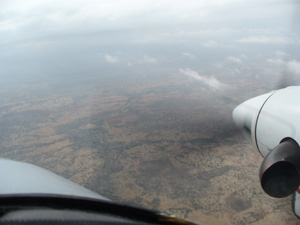 Gravity surveying is the process of measuring the
local gravitational field of the Earth.
Airborne gravity is the process of measuring and mapping these changes
in the gravity field with an airborne gravimeter on a helicopter or an
aircraft. It involves using ultra-sensitive equipment, called a gravimeter, to
look at the structure density of rock in the subsurface of the Earth. The idea
is based on a "Causative Body”, which produces a gravity anomaly. These
anomalies are analyzed by geologists who can assess the depth, size and shapes
of the subsurface anomalies.
Gravity surveying is the process of measuring the
local gravitational field of the Earth.
Airborne gravity is the process of measuring and mapping these changes
in the gravity field with an airborne gravimeter on a helicopter or an
aircraft. It involves using ultra-sensitive equipment, called a gravimeter, to
look at the structure density of rock in the subsurface of the Earth. The idea
is based on a "Causative Body”, which produces a gravity anomaly. These
anomalies are analyzed by geologists who can assess the depth, size and shapes
of the subsurface anomalies.
Gravity surveying is based on the theory of Newton's
Law of gravitation, which says that "the force of attraction between two bodies
of known mass is directly proportional to the product of the two masses and
inversely proportional to the square of the distance between them”.
Essentially, denser formations in the subsurface have a slightly higher
gravitational pull than normal formations.
The measurement of these anomalies is done with a
gravimeter. A traditional gravimeter works by using a very sensitive spring and
mass system. These instruments have a weight attached to a beam and also to a
spring. As gravity increases, the weight is pulled downward also pulling on the
spring. As gravity normalizes once past the increased gravitational force, the
weight and spring return to their original locations. Now, newer systems are
attempting to use lasers to achieve even more accurate results.
Once these measurements have been taken, corrections
need to be made on the gravity survey results. The main reason being the system
is so sensitive it is influenced by other factors. Airborne gravity surveys
have four factors to correct for;
-
Drift; A minor correction for stretching in the
spring throughout the survey.
-
Coriolis; A correction for the Coriolis Effect
due to the rotation of the earth.
-
Elevation; Correction for being above sea level.
-
Latitude; Correction for the location on Earth,
due to its shape.
The past decade has seen the constant development of
new and improved gravimeters from a number of different manufacturers measuring
a very high degree of accuracy. Accuracy is determined by analysing the
differenced at cross-over points from the survey data. The resolution of the
gravity data along line in a function of the speed of the vehicle/vessel and
the filter length applied to the data, typically from 3.5 to 5 km of
resolution. (Source; CMG)
New generation gravimeters back out the movement of
the aircraft from the data, providing a more accurate measurement. Once corrections are made to the data,
critical data information can be derived for mapping purposes. Looking at the
variation in gravity, one can interpret the different densities beneath the
surface. It can detect the size, shape and depth of the formation causing the
change in gravity. The most common applications for gravity surveying are
petroleum and natural gas, but also lead, zinc, copper, gold, uranium, and
iron.
Airborne
Gravity Survey Specifications;
Although results vary from system to system, superior
gravity data is generally acquired at night when survey aircraft can fly in
less turbulent conditions. Gravity
systems cannot operate will in conditions above 15 knot, or on more than a 20
degree bank of the aircraft. Therefore,
aircraft are selected that can provide the most stable flight path possible at
a relatively slow rate of speed, typically 200-240 km/h and stay airborne for
as long as possible.
Gravity surveys are typically flown at ~1,000 ft
elevation and with traverse lines of not less than 250 m line spacing.
Gravity surveys can be flown with in combination with
magnetics and radiometrics instruments to increase the survey benefits. Airborne gravity provides an economical
alternative to ground and gravity technology and therefore an excellent
starting point for your exploration program.